

Numbers
Numbers Used by Native Americans
By Mary Gage
The term “number” refers to a specific set of digits. Some number’s originate come from natural cycles such as the days in the month of the moons’ monthly cycle or the months in the moon’s yearly cycle. Other numbers like two and three were diversified in their origins. One group derived the number three from the three points on a triangle, while another group used the number three to acknowledge three spirits.
How each number was incorporated depended upon the time period, the group using the number and for what purpose. In some cases, the actual number is represented in other cases it is obscure as it was built into the complexity of the site.
Two
(1) Two Identical Features
A. Two spots of same color and size (America’s Stonehenge, No. Salem, NH)
B. Two basins on top of a boulder (Gungywamp, Groton, CT)
C. Two enclosures side by side (St. Martin Site, E. Kingston, NH)
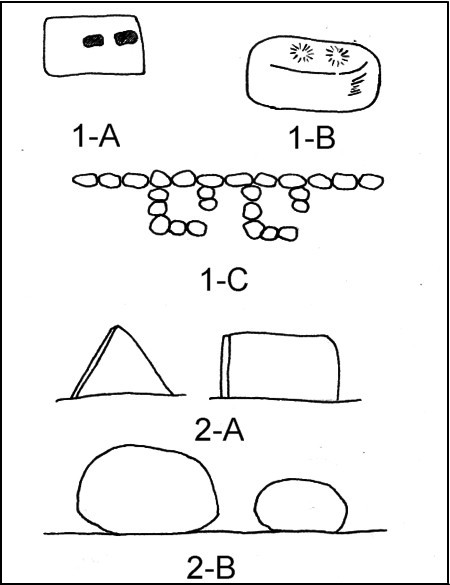
(2) Pairs of Two
A. Triangle and Rectangle (America’s Stonehenge)
B. Two boulders of unequal size (Rhode Island)
C. Two chambers one for preparation and second for main ceremony (Connecticut)
D. Two enclosures one without a spirit and second with a spirit (I. America’s Stonehenge via the presence or lack of a spirit portal) (II. Newbury, MA cairn site via the presence or lack of a Manitou Stone)
E. Two main ceremonies – America’s Stonehenge on summer solstice Rain Water & Crystal verses Spring Water; Gungywamp Moon Returns to Upperworld verses
F. Sun Enters Underworld
G. Winter Solstice verses Summer Solstice
H. Sunrise verses Sunset
I. Shaman & Ordinary People
J. Sun Spirit of Upperworld verses Underworld Spirit of Underworld (two spirits at same site)
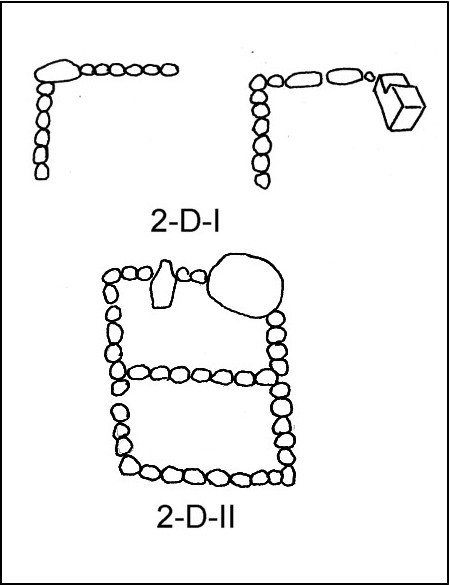
The concept of two was to create balance. To the Native American balance was formed by having two parts. The parts could be identical or different. The number did not exist as a separate entity it was always integrated into the ceremonial features/structures and spirits/ceremonies. This is seen at numerous stone structure ceremonial sites throughout the northeast. It comes in the form of two different areas within a site, pairs of chambers, etc. (see above). At stone structure sites spirits were called to participate in ceremonies. Some sites show evidence of two spirits or pairs of spirits. The use of the number two in regards to balance is fully explained in America’s Stonehenge Deciphered (2006) and in the web page article on Gungywamp.
At America’s Stonehenge in addition to balance the number two was used for protection. Two types of examples were incorporated: the pair of triangle and rectangle, and two spots. The triangle and rectangle combination had dual usage as balance and protection when used as a pair. The two shapes were not always used as pairs at the site but were always associated with protection. Two spots in each case were associated with the protection of two specific spirits.
In the field, look for the listed examples. Some cairn sites exhibit two sections one with specialized cairns and second a general section with numerous cairns often times with an extra large cairn. The specialized section is shaman while the general section is ordinary people. To have balance there was a need for pairs of spirits. This is not so easy to identify but on occasion can be done. Split boulders with and without fill place the Underworld Spirit at the site. Alignments with the sun place the Sun Spirit at the site. Generally either a sunrise or sunset was used not both. Manitou stones place an unknown spirit at the site. Images whether pictograph or petroglyph when decipherable can assist in figuring out other types of spirits present. Fire hearths at stone structure sites indicate Fire Spirit was present. An example of two spirits is seen at Sandown, NH where the Underworld Spirit is represented by a split boulder next to a large cairn in the general ordinary people’s section and Sun Spirit is represent by a sunset alignment in the shaman’s section.
Three
(3) Three Features - “In a Row”
A. Three triangular standing stones in-line at end of stone wall and above a split stone spirit portal (America’s Stonehenge)
B. Three short triangular standing stones spaced apart but in a row across top of an elongated cairn (Gungywamp)
C. Three triangular standing stones graduated in height embedded in interior wall of a chamber in Thompson, CT
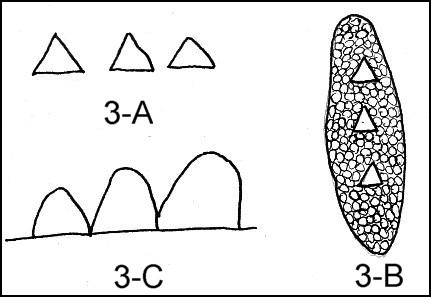
(4) Three Features - “In a Triangular Pattern”
A. Three standing stones arranged in a triangular pattern on top of the French Chamber in CT
B. Three niches on the ground laid out in a triangular pattern (Miner Farm, Hopkinton, RI)
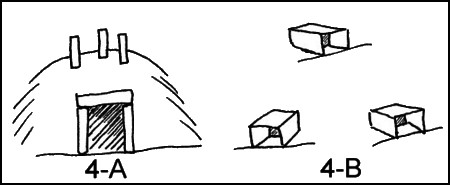
The number three is often times integrated with triangles. Triangles naturally have three corners or points. The number three was used in the same manner as the triangle to block out uninvited spirits. At America’s Stonehenge the three triangles were used to block out three specific spirits. In the Connecticut examples the three was used as a general blocking mechanism to block out all uninvited spirits. Miner Farm (Hopkinton, RI) has three niches arranged in a triangular pattern. The triangle suggests the layout was used to block out uninvited spirits while the niches suggest three spirits were invited to the ceremony. Invited spirits are not blocked by the any blocking symbolism. This particular site is under study.
(5) Two Sets of Three - “One Set Inside Another Set”
A. A standing stone and bridge cairn set in each of the three corners of a triangle enclosed the main ceremonial area of a stone structure site. Within the greater area is a second set of three standing stones that enclosed one of the two main ceremonies held at the South Complex at Gungywamp in CT
B. In the North Complex of the Gunywamp site is an elongated triangle formed by a pair of standing stones on one end and single standing stone on the other end encloses the width of the site and an elongated stone cairn with a set of three triangular standing stones on top
C. In Dogtown at Gloucester, MA a triangular shaped enclosure was created by two perched boulders and a pedestal boulder. Pedestal boulder is raised on three support stones laid out in the shape of a triangle.
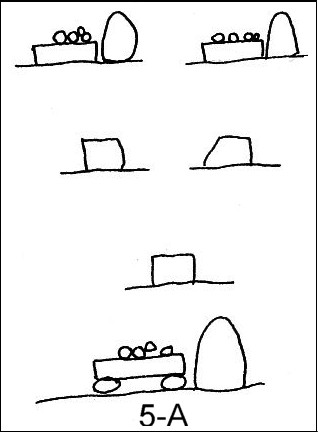

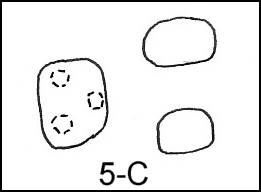
(6) Two Sets of Three - “Two Sets Beside Each Other”
A. In South Royalton, Vermont at monolith “A” site there are two triangular shaped enclosures. Monolith Site A is a quarter mile from the Calendar 1 complex and six hundred feet from V.H.S. chamber no. 9 (Whittall, 1984: pp 34-35). Each triangle is made up of three standing stones and is similar in size. The triangles are separate from each other. The closest stone of each one places the bottom of the two triangles four and half feet apart. One is associated with a cairn and is oriented north. Cairn is at tip on north end outside the triangle enclosure. Second triangular enclosure is associated with a fire and patch of red ochre, and is oriented west and slightly north. Fire pit (eighteen inches diameter) and red ochre deposit (eighteen inches diameter) are on bedrock abutting each other and adjacent to splits in the bedrock approximately three feet away from monolith A in bottom part of triangle enclosure on south corner. Monolith was placed in a quarried niche in the bedrock. Charcoal from fire pit dated to 435 +/- 145 B.P. (GX-10519). According to Whittall’s report an excavation at Calendar 1 complex produced a C-14 date of 470+/_ 150 B.P. (GX-9782) placing it with in the same time period of usage. Here two separate triangular enclosures were used for different purposes and different ceremonies. Only one monolith “A” was excavated. It is unknown if other buried features are associated with either triangular enclosure. Chamber no. 9 is six hundred feet distant close enough to be possibly associated with the triangular enclosures. Monolith A was placed in a quarried out hole in the bedrock. Nearby are natural splits in the bedrock. Splits in bedrock and chambers are indications of the Underworld. Balance is indicated by the two triangles. Balance also shows up in the fire pit and red ochre deposit as two features that are of equal size and same semi-rectangular shape.
B. America’s Stonehenge spirit passage cairn has three spirit passages made up of two stones apiece and arranged atop a large flat-topped boulder with three tiny quartz protrusions. (The three quartz protrusions were used as protection to block out uninvited spirits and the three pairs (2) of stones were used for spirits to have a formal entry into the site, a passage.)
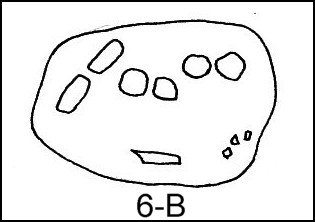
The use of a triangle within a triangle at Gungywamp creates a double set of triangles. Both sets of triangles were used to block out uninvited spirits. The second set may represent a form of balance as in two chambers per ceremony. The Vermont site may have also used two triangles for the sake of balance possibly splitting up one ceremony into two parts or holding two ceremonies on the same day. In each case, three standing stones set up in the shape of triangle were used. This incorporated two elements the number three and the triangle shape both associated with blocking out uninvited spirits.
(7) Two & One (equal to three)
A. Pair (two) standing stones placed together, third standing stone placed on other side of site with stone structure features in the middle, technically a slim triangle at Gungywamp in CT
B. Two vertical lines, an empty space and one vertical line 11 1. Arrangement of carved lines was done on anchor boulder at entrance to Hunt Brook Chamber in Montville, CT
C. Two perched boulders and one pedestal boulder together make up three boulders arranged in a triangle pattern (Dogtown in Gloucester, MA)
D. In Freetown, MA there is a cairn with two charcoal deposits and one red ochre deposit. (Mavor & Dix, 1989: 66)This one is inconclusive but fits the pattern. It creates a situation whereby three separate, special offerings were made. The three offerings were made at intervals not at the same time, therefore the two n’ one combination that it fits may not apply.
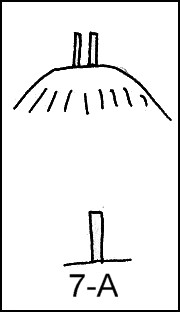
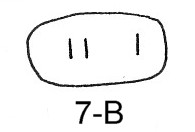
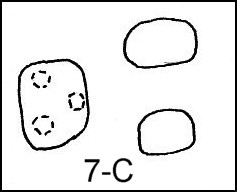
The two & one combination creates a number three and was used to block out uninvited spirits in Connecticut and Gloucester, MA. Some times it incorporates a triangle and other times, it does not. The Freetown, MA cairn was analyzed under Color. Its two & one pattern appears to be associated with offerings to a Manitou Spirit within the cairn.
(8) 1900’s Interpretation of Number Three
A. In the The Last Algonquin a Long Island Indian had to be asked three times before he told his story. The biographer was not able to learn the meaning behind the three times. It is simply brought out as a fact that took place.
B. In current times the Northeastern Native American culture refers to the number three as representing three worlds Underworld (below) – Middleworld (earth’s surface) – Upperworld (sky)
C. In current times the number three is also applied to the three sisters - beans, corn and squash. How far back this association with the number goes is unknown. Agriculture gets its start in New England in the Late Woodland Period.
D. In Medicine Trail a book about Gladys Tantagquidgeon’s life and documentation of Mohegan culture past and present the number three is mentioned in relation to the Little People. Granny Squannit leader of the Little People had two diamond eyes and a central spirit eye. (p 84) This information dates to the 1920’s.
The 1900’s interpretations show modern thinking with links to the past. Three worlds – Upperworld, Underworld and Middleworld are recognized and acknowledged at America’s Stonehenge and Gungywamp sites. At America’s Stonehenge early on Upperworld and Underworld are utilized as two parts within the concept of balance. When Middleworld is introduced it was used with one other world to have two parts to maintain balance. In neither site is there any evidence that the number three was used to represent the three worlds.
There is a broad and diversified range of uses. The Last Algonquin needed to be asked three times before he would tell his story. Gladys Tantagquidgeon’s brings us Granny Squannit who has three eyes, the third being a spirit eye. This is a two & one combination creating three eyes. It suggests a link with the past within the geographical area. Current generalized interpretations refer to the three worlds and/or three sisters of agriculture. These last two appear to be very late ideas adapted to common knowledge.
Four
This number although in use currently with Native Americans in the northeast in reference to the four cardinal directions has not shown up at stone structure sites.
Five
This number has only two examples. They are two pedestal boulders with five support stones in New York State. Nothing more is known about the number. (See Pedestal Boulders)
Twenty-Nine
Number twenty-nine was used at Gungywamp in rows of standing stones. It represents the moon and its month long cycle. Two separate rows of standing stones varying in height each appear to have twenty nine stones. One row replaced the other row when the older row no longer fulfilled the needs of the ceremony. Additional features were made to the new row which created the need for the second row. This is the only site that utilized a number to represent the moon. (See Gungywamp article)
One Hundred Years
Several sites exhibit evidence of a number close to a one hundred year interval. They indicate the number had significance and warranted a special ceremony to acknowledge an event. The sites are America’s Stonehenge in North Salem, NH, Gungywamp in Groton, CT and a cairn site in Freetown, MA.
1) Freetown, MA cairn is earliest known example occurring in the early part of Late Woodland. Within the cairn are two charcoal deposits. They have C-14 dates of 790 B.P. and 875 B.P. The dates are eighty five years apart given the plus and minus values the dates suggest a one hundred year span. (Mavor & Dix, 1989: 66)
2) America’s Stonehenge in North Salem, NH has three features set up approximately one hundred years apart. The first is a specialized split boulder cairn. The split was left open without stone fill and on the opposite end are three stones that make up the cairn. It has not been dated by C-14 method but fits into a scenario that dates it to circa 1800. The cairn is located in the same area as two other hundred year features. The second is a set of three objects that can carry water from circa 1900. The objects are spread out around western perimeter of site and are a metal pail, an enameled cooking pot and a ceramic jug. The enameled cooking pot was dated via its pattern in an old Sears catalog. The third are a set of three bent tree saplings. These are young trees ten years and less that were found bent in 2005 and all are in an east – west line up in area of ceramic jug and split boulder cairn. (Gage, 2006)
3) Gungywamp Site in Groton, CT has two dated features that indicate a one hundred year ceremony was observed. The first is a crude hearth inside entrance of an open-roofed enclosure in the North Complex. The charcoal from hearth was dated to 130 +/- 75 B.P. [1820 A.D.]. The second is a dated 1916 trolley token found near the open front (entrance) of a Native American Indian lodge. Each dated feature was at the entrance of a structure. This site continues to be visited by unknown visitors periodically as noted by the Gungywamp Society who are the caretakers. The same scenario has been observed at America’s Stonehenge site that also has unknown [Native American] visitors periodically on its perimeter (observed by the author). Findings indicate Native American ceremonialism.
Conclusion
There is no indication of the significance of the One Hundred Year Ceremony. It dates back at least nine hundred years to the early part of the Late Woodland period. It continues to be celebrated as of the twenty-first century circa 2000. The concept of one hundred was derived from the Freetown, MA cairn with its C14 dates, and at America’s Stonehenge and Gungywamp sites with their modern dated objects.
The lunar standstill occurs every nineteen years. Five lunar standstills add up to ninety-five years. The only features with number five are the two pedestal boulders in New York of which no interpretation for the number of support stones is known. This number five does not appear to be relative to the hundred year ceremony.
The most current evidence at America’s Stonehenge suggests the current Native Americans observe the event near the turn of the century. In Connecticut at Gungywamp the 1916 trolley token suggests a specific year.
Bibliography
Gage, Mary
2006 America’s Stonehenge Deciphered. Amesbury, MA : Powwow River Books.
Fawcett, Melissa J.
2000 Medicine Trail: The Life and Lessons of Gladys Tantaquidgeon. Tucson, AZ: University of Arizona Press.
Kazimiroff, Theodore L.
1982 The Last Algonquin. New York, NY: Dell Publishing Co.
Mavor, James & Byron Dix
1989 Manitou: The Sacred Landscape of New England’s Native Civilization. Rochester, VT: Inner Traditions.
Whitall, James II.
1984 “Excavation - `Monolith A’ Site South Royalton, Vermont” Early Sites Society Research Bulletin vol. 11 no. 1 pp. 34-36.


|
Website - Copyright (c) 2005-2007, James Gage & Mary Gage. All Rights Reserved. |

